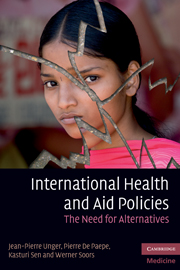Book contents
- Frontmatter
- Contents
- Preface
- Biographies
- Notices
- Acknowledgements
- List of abbreviations
- Reviews
- Introduction: Overview and purpose
- Section 1 Paradigms of international policies
- Section 2 The failure of the aid paradigm: poor disease control in developing countries
- Section 3 Impact of international health policies on access to health in middle-income countries: some experiences from Latin America
- Section 4 Determinants and implications of new liberal health policies: the case of India, China and Lebanon
- 9 Political and economic determinants of health care systems: the case of India
- 10 An economic insight into health care provision in six Chinese counties: equity in crisis?
- 11 Health care financing and delivery in the context of conflict and crisis: the case of Lebanon
- Section 5 Principles for alternative, publicly oriented health care policies, planning, management and delivery
- Section 6 A public health, strategic toolkit to implement these alternatives
- Conclusions
- Glossary
- Index
- References
9 - Political and economic determinants of health care systems: the case of India
Published online by Cambridge University Press: 06 December 2010
- Frontmatter
- Contents
- Preface
- Biographies
- Notices
- Acknowledgements
- List of abbreviations
- Reviews
- Introduction: Overview and purpose
- Section 1 Paradigms of international policies
- Section 2 The failure of the aid paradigm: poor disease control in developing countries
- Section 3 Impact of international health policies on access to health in middle-income countries: some experiences from Latin America
- Section 4 Determinants and implications of new liberal health policies: the case of India, China and Lebanon
- 9 Political and economic determinants of health care systems: the case of India
- 10 An economic insight into health care provision in six Chinese counties: equity in crisis?
- 11 Health care financing and delivery in the context of conflict and crisis: the case of Lebanon
- Section 5 Principles for alternative, publicly oriented health care policies, planning, management and delivery
- Section 6 A public health, strategic toolkit to implement these alternatives
- Conclusions
- Glossary
- Index
- References
Summary
Qadeer Imrana (2009) Political and Economic Determinants of Health: the case of India in Cook, H, Bhhatacharya, S and Hardy. A History of the Social Determinants of Health, Orient Black Swan (eds), India pp. 228–248
Introduction
Politics, as the dynamics of managing stratified society, is linked to the control by different social-strata resources and production systems. Indian society is differentiated along the lines of class, caste, and gender among whom the rich peasantry and landlord-industrialists combine to control national politics. The former used their power to keep agriculture tax-free and resisted land reforms, while the latter neglected the production of low cost basic consumer goods in order to focus on an elite market. On the other hand, poor and marginal peasants, agricultural labourers and a relatively small industrial working class constitute the majority of the population – 93% of them are in the unorganized sector. In between come the middle class whose growth, beginning in the 1970s, has expanded the market potential of India. Conflicts between these three broad groups, with different political interests, are often used by the political forces for their own survival.
The development of the health sector in India reflects, to a large degree, the interest of the dominant classes; this influence became more evident since the introduction of SAPs. Notions such as CHC, the integration of disease control with medical care which were antithetical to the spread of market forces, were replaced by essential primary care, and PPPs under the aegis of SAPs.
- Type
- Chapter
- Information
- International Health and Aid PoliciesThe Need for Alternatives, pp. 109 - 122Publisher: Cambridge University PressPrint publication year: 2010



